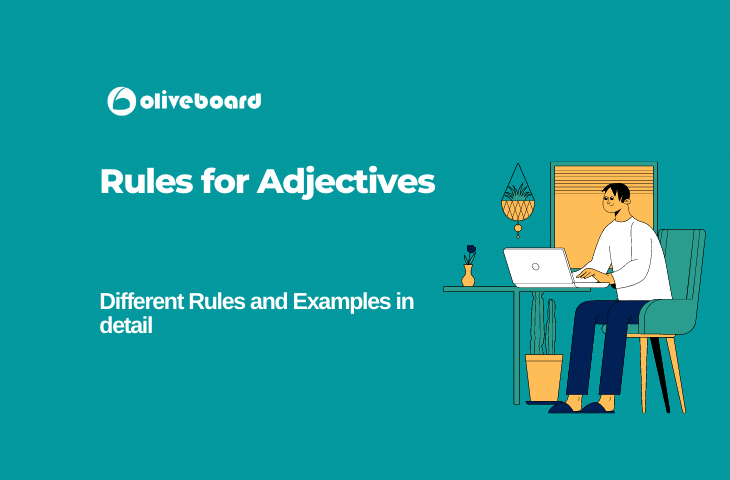Almost all competitive exams include questions on English grammar, be it the SSC, Banking, or Railways. However, becoming fluent in English is beneficial not only for the recruitment exam but also for improving one’s social life.
Since government recruitment exams are approaching fast, it’s more important to practice English grammar. We have compiled this guide covering information on the adjective definition, usage, examples, and rules to help prepare our readers for the English section of the exam. We encourage the aspirants to read carefully and practice previous year’s papers and online mock tests to improve their overall command of the language and brush up on their knowledge of the rules for adjectives.
What are Adjectives?
Adjectives are words that describe a noun or a pronoun in greater detail. These words provide more information about the characteristics of a person, an animal, or a thing. They usually come before the thing they’re talking about (after only a few cases). Adjectives define the word they are referring to (antecedent) in more detail, such as small, old, seven, deep, etc.
Examples:
- Adjective before a noun:
Anamika has a beautiful doll.
In the above sentence, ‘doll’ is a noun and ‘beautiful’ is an adjective that defines the characteristic of the doll.
- Adjective before a pronoun:
Ram bought a car. It’s a new one.
In this example, ‘one’ is a pronoun, and ‘new’ is an adjective.
In most cases, adjectives come before their antecedent (the word they modify). They may, however, appear elsewhere in the sentence. This is particularly true after verbs like be, get, seem, become, appear, and with verbs that describe the senses like taste, feel, smell, look, and sound.
- Adjective after the verb:
Shyam is smart.
She seems happy.
The food smells good.
Here, smart, happy, and good are describing words that followed the verbs.
Types Of Adjectives
An adjective is classified according to how it is used in a sentence, i.e., Attributively (before the word) or Predictively (after the word).
- Attributively: A pretty girl married Amit. A bright boy won the award.
- Predicatively: Amit is handsome. The winner was bright.
Adjectives are of the following types:
1. Adjective of Quality (Descriptive Adjective): It describes the characteristics of a person, an object, or a place.
Lara eats fresh fruits. He is a trustworthy individual.
2. Adjective of Quantity: It expresses the quantity (how much) of something, such as some milk, a lot of patience, etc. It provides an answer to the question, “How much?”
He handed me some cash.
3. Adjective of Numbers (Numerical Adjective): It specifies the number of items or shows how many people, things, or places are involved, as well as the order in which they appear, such as two pictures, five women, the first, second, or last painting, some apple, and so on.
There are two types of numeral adjectives:
- Definite (three, six, first, sixth, one dozen) numeral adjectives
- Indefinite (some, few, many, any) numeral adjectives
4. Demonstrative Adjective: It specifies who, where, or what is being referenced.
Example: this cabin, that fellow, those birds, that park, etc.
This and These show proximity, while That and Those show distance. Singular nouns use This and That, while plural nouns use These and Those.
5. Interrogative Adjective: It asks a question concerning a noun or a pronoun.
Example: What time is it? Which book is yours? Whose pencil is this?
Here words, what, which, and whose are interrogative adjectives.
6. Distributive Adjective: It refers to each one in a group.
Example: each student, every person, neither section, either son, etc.
7. Possessive Adjective: It indicates ownership of something, someone, or somewhere. My, your, our, his, her, their, its, etc., are used as possessive adjectives.
Example: His brother is a trustworthy individual. Your turn is over now.
Here, his and your are possessive adjectives.
8. Proper Adjective: It refers to an adjective formed from a proper noun.
Example: Indian architecture, Chinese food, Gandhian philosophy, etc.
9. Exclamatory Adjective: When the word ‘what’ appears in an exclamatory sentence, it becomes an exclamatory adjective.
Example: What a lovely painting! What a brilliant concept!
Degrees of Adjectives
Adjectives have three types of degree:
1. Positive Degree: When there is no comparison.
Ravi is tall.
2. Comparative Degree: When there is a comparison between two things, places, or persons.
Ravi is taller than Shweta.
3. Superlative Degree: It denotes the highest degree of quality.
Ravi is the tallest boy in the class.
Rules for Arranging Multiple Adjectives before a Noun
Over three or four adjectives are rarely used before a noun unless they are extremely descriptive. When there are multiple adjectives, the widely accepted method for arranging these adjectives in a specific order is as follows:
Number, Opinion, Size, Age, Shape, Colour, Origin, Material, Purpose
Use the first alphabet of each word in seriatim to learn the sequence of adjectives as NOSASCOMP.
Examples:
A gorgeous, large, round, brown, metallic box.
An attractive, short, young, slim, fair girl.
Five small, oval, wooden, pink study tables.
The sentences above are solely for academic purposes. Rarely are so many adjectives used in one sentence. Two adjectives are sometimes used to describe a single quality. In that case, ‘and’ is used between them. For over two adjectives, a comma separates all the adjectives.
FAQs:
Adjective of quality
Adjective of quantity
Adjective of number
Proper Adjective
Demonstrative Adjective
Distributive Adjective
Interrogative Adjective
Possessive Adjective
Exclamatory Adjective
According to the rules for adjectives,
Rule 1: Add ‘er’ and ‘est’ to the positive degree to make the comparative and superlative degrees.
Example: Bold (Positive), Bolder (Comparative), Boldest (Superlative)
Rule 2: If a positive degree ends in ‘e,’ add ‘r’ to make it comparative and ‘st’ to make it superlative.
Example: Brave (Positive), Braver (Comparative), Bravest (Superlative)
Rule 3: For positive degrees ending in consonants with short vowels, double up the consonants before adding ‘er’ and ‘est’ to make comparative and superlative degrees, respectively.
Example: Big (Positive), Biggest (Comparative), Biggest (Superlative)
